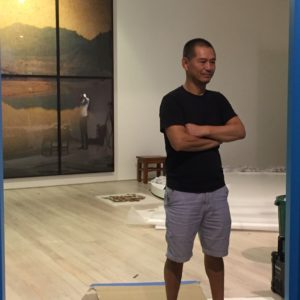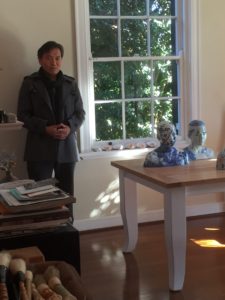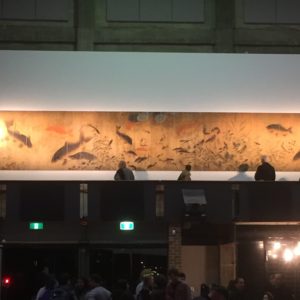Archive for August, 2016
Guo Jian and Ah Xian
Aug 1st
An extraordinary thing happened at the Casula Powerhouse last Friday night.
It was the opening night of the new Refugees exhibition, which includes the now Sydney-based Chinese artists Ah Xian and Guo Jian.
Cast your mind back to 1989 and the infamous Tiananmen Square massacre of pro-democracy protesters by government armed forces.
Ah Xian and Guo Jian were both there, both witnesses to the slaughter.
Guo Jian was a student protester and hunger striker inside the square. Ah Xian, a commercial artist at the time, had cycled to the perimeter of the square every day to see what was going on.
Ah Xian had told me a few weeks ago about his memories of Tiananmen Square. He had seen many bodies stacked on top of one another in a bicycle shed at Fuxing Hospital. He presumed that the hospital was overflowing with the dead and dying, and that the shed was a makeshift morgue. I asked Ah Xian who would have put the bodies in the shed, but he wasn’t sure.
Fast forward to last Friday night at Casula. I’m chatting with Guo Jian, telling him about my interview with Ah Xian. When I tell him about the bicycle shed with bodies in it, Guo Jian says: “Yes, I was one of the people putting them there”.
Guo Jian recalled slipping on blood an inch deep on the ground, and seeing people die before his eyes.
So here were these two men, 27 years after they had both been at Tiananmen Square. Somehow, to me, it seemed quite remarkable.
Ah Xian did his first piece of performance art on opening night of Refugees. For three hours he sat completely still in a purpose-made box. Only his head and chest were visible through a perspex display case at the top of the box.
Those who know Ah Xian’s porcelain painted busts will immediately recognise the similarity between them and the performance.
Guo Jian’s work in the Casula Powerhouse exhibition included a picture that he made especially for the show.
Titled Picturesque Scenery No. 27, the work is a pigment print on photo paper in 26 panels. It exactly mimics a famous, Song-dynasty painting of fish swimming in a pond.
However, get up close to Guo Jian’s version, and you can see the picture is made up of literally millions of tiny photographs of people’s faces.
These came from Guo Jian’s home town, which is noted for its beauty.
But Guo Jian was appalled to return there after many years to find enormous amounts of rubbish in the river whose pure water he often drank as a child. He photographed the celebrity faces on wrappers discarded in the river, and now uses them as elements in giant collages. It is only up close that the viewer can see these tiny faces, not much larger than a match head.
Elizabeth Fortescue, August 1, 2016



